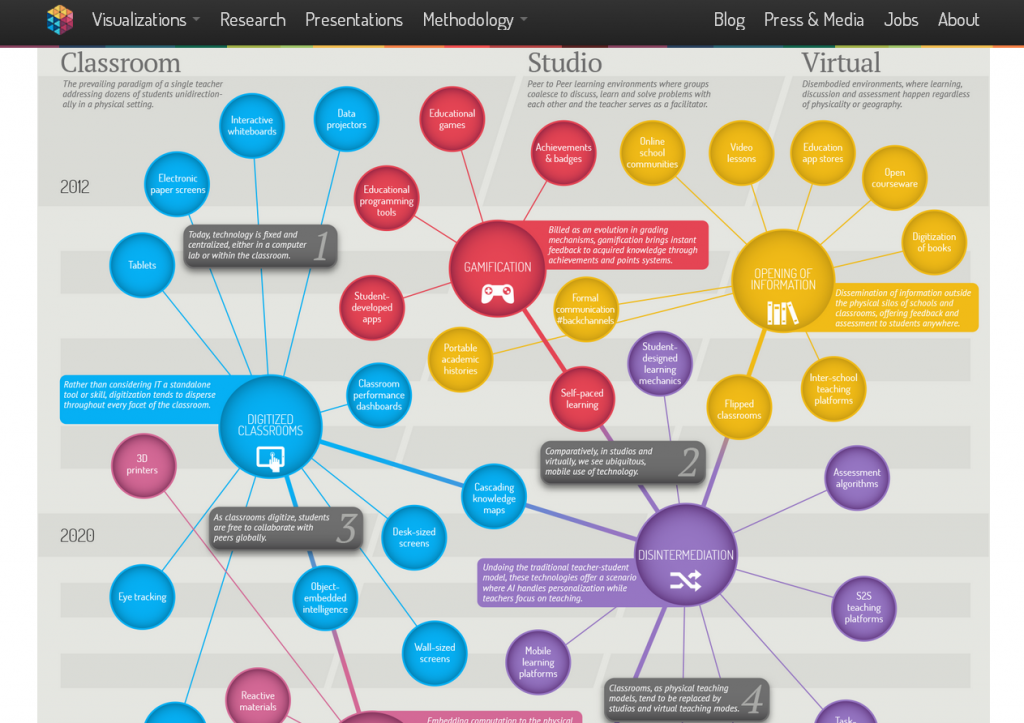The 102 page report may not be accessible to everyone in terms of taking the time to read it, so here are some salient points:
The Horizon Report identifies a number of meta-trends in ICT in education:
• the evolving approaches to communication between humans and machines
• the collective sharing and generation of knowledge
• computing in three dimensions
• connecting people via the network
• games as pedagogical platforms
• the shifting of content production to users
• the evolution of an ubiquitous platform.
The challenges for policy makers20 listed below are summarised from the discussions at the ICT in Learning Symposium and, along with the other references used, have helped shape this report’s recommendations. The challenges are:
• to provide a flexible framework that supports information sharing and reduces duplication through fragmentation of effort
• to choose where to invest in research, tools and systems that support integration
• to address the barriers to scaling innovative and transformative practice
• to monitor performance of the system against key outcomes that are learner focussed
• the development of a flexible national curriculum for schools and assessment so it is responsive to the potential of technologies to engage, enhance and improve learning outcomes for a 21st century economy
• the provision of tools, mechanisms and systems that encourage the development and sharing of content and of good teaching practice
• the development of policy frameworks that encourage widespread use of new technologies through a shared risk management approach the instigation and support of transformational professional learning programs across all sectors that effectively engage educators in incorporating the use of ICT to improve learner outcomes
• the provision of spaces and mechanisms for trial and evaluation of new ICTs and for sharing of good practice across sectors, between organisations, and across jurisdictions
• the development of a management, maintenance and governance model for managing a complex distributed and connected environment for all stakeholders
• the development of decision making frameworks that describe minimum standards for interoperability to encourage national integration of tools and services while allowing for local flexibility
• the provision of sandpit spaces for trial and evaluation of new technologies
• the promotion of frameworks and systems to encourage sharing of content and best practice in teaching and learning.
This report makes eight recommendations, each accompanied by suggested strategies to support the achievement of those recommendations. The recommendations are listed here, but should be read in concert with the strategies.
The recommendations are:
SICTAS: Planning for Change Education.au 10
• Implement an ICT in teaching and learning continuum so that learners’ new media literacyskills and abilities are augmented as they move through the education sectors.
• Task a national body to support national collaborative partnerships to reduce fragmentation of effort, and make best use of the existing and future investments made in ICT.
• Research and establish mechanisms to enable the more rapid adoption of innovative practice in the use of ICT across the teaching and learning workforce.
• Commit to providing ongoing resourcing and funding to maintain, sustain and enhance a technology rich environment for the education and training sector.
• Develop and implement a national approach to software infrastructure that minimises the barriers to effective use and sharing of resources, and maximises access.
• Address the complications of Australian copyright law in a way that encourages sharing and exchange of resources in the education and training sector, including the implementation of Creative Commons across Australian education and training.
• That the Australian Government takes a leadership role in collaboration with jurisdictions, sectors and educational institutions to develop a national professional learning strategy based on sound research into good practice.
• The Australian Government takes a leadership role, in partnership with other education authorities and entities, in implementing and maintaining the ICT competency framework for teachers as described in the ‘Raising the Standards’ report, but look to apply this to teachers in each of the education sectors. A key component of the described framework is teacher standards. The Government should undertake to task AICTEC, through its advisory bodies to develop teacher ICT standards for:
o Pre-service teachers
o Practicing teachers
o School leaders
o Teacher educators
o VET teachers
o University teachers
The report also provides a set of possible actions that could be taken to help position Australia to manage constant change in ICT in the education and training sector. A primary issue is delegation of responsibility: who will take responsibility for managing and implementing the range of actions, strategies and recommendations?
The current system of dispersed responsibility and fragmentation of effort does not enable strategic implementation ensuring equitable access to quality ICT in education for learners across jurisdictions and sectors regardless of where a learner or teacher is in the system.
Some of the Actions that are suggested in different areas are the same and therefore vital:
Having such a respected organisation reinforce many of the things that we all believe is powerful. Perhaps Principals and other leaders would like to read the report and implement some of the suggestions?


